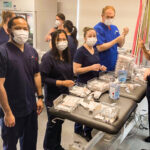Rural areas will still be susceptible when the cities pass 70%, and a ‘nightmare’ outbreak is far from impossible.
With New South Wales restrictions set to start easing once statewide vaccination targets are met, driven largely by high take-up in metro areas, will the regions be left exposed?
The state’s current outbreak, initially confined to Sydney, has seen vaccine availability surge in the capital city.
Rural and regional areas have been some of the last to receive vaccine stock – while Sydney hospitals joined the vaccine rollout in February, the first shipment of doses only arrived in Dubbo toward the end of March.
At one point, Pfizer vaccines bound for rural areas of the state were temporarily redirected to Sydney; although supplies were replenished in short order, many regional residents had vaccination appointments cancelled.
Despite first-dose vaccination levels in the regions accelerating over the last few weeks, postcode data released by NSW Health shows regional areas are lagging behind Sydney, especially in terms of double-dose rates.
Essentially, the potential exists for a situation where, when the state hits 70% double-dose vaccinated and restrictions begin to ease, a large portion of the fully vaccinated population will be concentrated in metropolitan Sydney.
Dr Charles Evill, president of the Rural Doctors Association of NSW, told The Medical Republic that a widespread outbreak in the regions over the next several months was very possible.
“As of last week, sometime, the double vaccination rate was largely below 40% [in non-metro areas],” he said.
“It would be of concern if the epidemic were allowed to spread through a population with that level of vaccination, because we’d be likely to get extremely rapid spread.”
This would then be exacerbated by the limited resources available to country hospitals.
“Most small hospitals don’t even have an intensive care bed, let alone a negative pressure room or adequate patient isolation,” Dr Evill said.
“They would simply be unable to deal with a high rate of seriously sick people.
“The usual response for seriously sick people is to transfer them to the next level of care, but if you’re talking about base hospitals like Tamworth, Dubbo and Orange – they have a limited number of intensive care beds anyway.
“You’re not really helping all that much by simply shifting everything from the small hospitals into the next level up.”
From there, he said, the patient transport system would quickly begin to buckle and capacity to care for people with other illnesses would be greatly decreased.
“Without having actual figures to put to it, it would be some kind of a nightmare to have rapid spread in rural and remote areas,” said Dr Evill.
While he acknowledges that the likelihood of such a situation actually unfolding is a “Hollywood worst case scenario”, Dr Evill stressed the need for GPs working in regional Australia to keep pressing forward with the rollout.
Despite the initial challenges in securing supplies, Dr Evill said that many rural practices were now receiving enough vaccines to meet the demands of their community.
He said a colleague who worked in general practice and in an Aboriginal medical service had only just secured access to Pfizer vaccines after many weeks of trying, and was now going flat out.
“He is vaccinating just as hard as he can go,” Dr Evill said.
“I think he said he’s doing about 60 people a day, which for one person with an RN is a pretty steady go.”
A roadmap out of Victoria’s latest lockdown, which has also seen regional areas affected, is expected by this weekend.
Main image: Verandahs, Wilcannia, by Ross Zimmermann at Flickr.com





